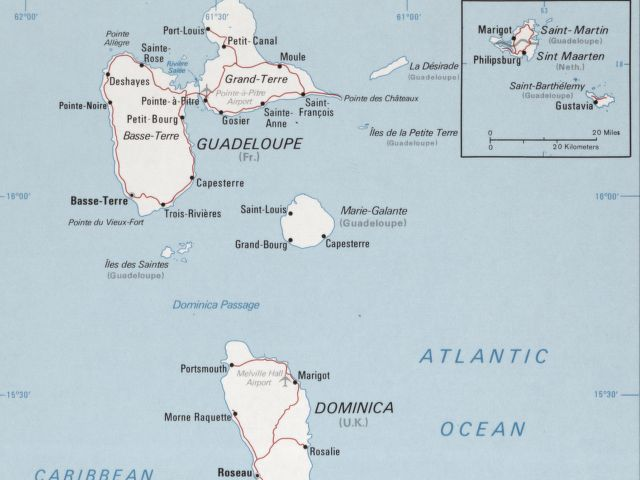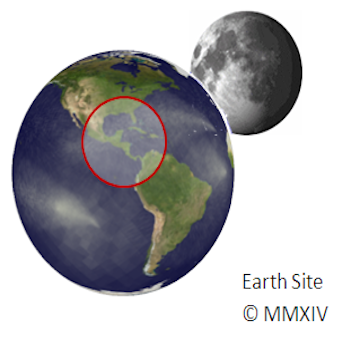Guadeloupe
(Département d’Outre-Mer de la Guadeloupe (Overseas Department of Guadeloupe))





Capital of Guadeloupe: Basse-Terre
Population (Estimated July 2012): 454,000
Area: 1,630 km2 or 629 mi2
Currency: Euro (€)
Official Language: French
Political Information: Overseas Region of France
Official Religion: No Official Religion
Time Zone (GMT/UTC):
Leaders: President François Hollande with President of the General Council Jacques Gillot and President of the Regional Council Victorin Lurel.
Sources: CIA World Fact Book, Encyclopaedia Britannica.
Guadeloupe
Guadeloupe is a stunning archipelago located in the Caribbean, known for its beautiful beaches, lush rainforests, and vibrant culture. It is an overseas region of France and is composed of several islands, with the two main ones being Basse-Terre and Grande-Terre. The islands are surrounded by crystal-clear waters and offer a perfect blend of French and Caribbean influences. Guadeloupe is a popular destination for tourists seeking a tropical paradise with a touch of European charm.
The islands of Guadeloupe are rich in history and culture, with a diverse population that includes people of African, European, and East Indian descent. The official language is French, but Creole is widely spoken and is an integral part of the local culture. The music, dance, and cuisine of Guadeloupe are a reflection of this cultural diversity, making it a fascinating destination for those interested in experiencing the unique blend of Caribbean and European influences. With its stunning natural beauty and rich cultural heritage, Guadeloupe offers a truly unforgettable experience for visitors.
History and Culture of Guadeloupe
The history of Guadeloupe is a complex tapestry of colonialism, slavery, and resistance. The islands were originally inhabited by the Arawak and Carib people before being colonized by the French in the 17th century. The sugar industry brought an influx of African slaves to the islands, and the legacy of slavery continues to shape the culture and identity of Guadeloupe today. The islands have a long history of resistance and rebellion, with several uprisings against colonial rule, including the famous slave revolt led by Louis Delgrès in 1802.
The culture of Guadeloupe is a vibrant mix of African, European, and Caribbean influences. Music and dance are integral parts of the local culture, with traditional styles such as Gwo Ka and Zouk coexisting alongside modern genres like reggae and hip-hop. The cuisine of Guadeloupe is also a reflection of this cultural fusion, with dishes that blend French culinary techniques with local ingredients such as seafood, tropical fruits, and spices. The islands are also known for their vibrant festivals and celebrations, including Carnival and the Fête des Cuisinières, which showcase the rich cultural heritage of Guadeloupe.
Geography and Climate of Guadeloupe
Guadeloupe is an archipelago located in the Leeward Islands of the Caribbean, with Basse-Terre and Grande-Terre being the two main islands. The landscape is diverse, with lush rainforests, volcanic peaks, and stunning beaches. Basse-Terre is home to La Soufrière, an active volcano that is the highest point in the Lesser Antilles. Grande-Terre, on the other hand, is known for its beautiful beaches and rolling hills. The islands are surrounded by coral reefs, making them a popular destination for snorkelling and diving.
The climate of Guadeloupe is tropical, with warm temperatures year-round and a wet season from June to November. The islands are prone to hurricanes during the wet season, so visitors should be mindful of weather forecasts when planning their trip. The trade winds help to keep the islands relatively cool, making it a pleasant destination for outdoor activities such as hiking and beach-going. With its diverse landscape and favourable climate, Guadeloupe offers something for every type of traveller, whether they are seeking adventure in the rainforest or relaxation on the beach.
Cuisine and Local Delicacies of Guadeloupe
The cuisine of Guadeloupe is a delicious blend of French culinary techniques and local ingredients, resulting in a unique and flavourful dining experience. Seafood plays a prominent role in Guadeloupean cuisine, with dishes such as court-bouillon (fish stew) and accras de morue (cod fritters) being popular choices. Local fruits such as guava, passion fruit, and mango are also used to create refreshing juices and desserts. One of the most iconic dishes of Guadeloupe is bokit, a fried bread filled with various ingredients such as chicken, fish, or vegetables.
Rhum agricole is a popular local spirit made from sugarcane juice, and it is used to create a variety of cocktails such as ti’punch and planteur. Visitors to Guadeloupe can also sample local delicacies such as boudin (blood sausage), colombo (a spicy curry dish), and dombrés (dumplings). The islands are also known for their vibrant markets where visitors can sample fresh produce, spices, and local specialities. With its diverse range of flavours and ingredients, the cuisine of Guadeloupe is a true reflection of the islands’ rich cultural heritage.
Popular Tourist Attractions in Guadeloupe
Guadeloupe offers a wide range of attractions for visitors to explore, from stunning natural landmarks to historical sites and cultural experiences. One of the most iconic landmarks in Guadeloupe is La Soufrière, an active volcano located on the island of Basse-Terre. Hiking to the summit of La Soufrière offers breathtaking views of the surrounding landscape and is a popular activity for adventurous travellers. Another must-see natural attraction is the Cascade aux Ecrevisses, a beautiful waterfall nestled in the heart of Basse-Terre’s rainforest.
For those interested in history and culture, Guadeloupe offers several fascinating sites to explore. The Memorial ACTe in Pointe-à-Pitre is a museum dedicated to the history of slavery and its impact on the Caribbean region. The museum provides a thought-provoking look at this dark chapter in history and its lasting effects on the people of Guadeloupe. The islands are also home to several charming towns and villages with colourful colonial architecture, such as Sainte-Anne and Deshaies. With its diverse range of attractions, Guadeloupe has something to offer for every type of traveller.
Activities and Outdoor Adventures in Guadeloupe
Guadeloupe is a paradise for outdoor enthusiasts, offering a wide range of activities to enjoy amidst its stunning natural beauty. The islands are home to several national parks and nature reserves, providing ample opportunities for hiking, birdwatching, and wildlife spotting. The Parc National de la Guadeloupe encompasses much of Basse-Terre’s rainforest and is home to diverse flora and fauna, including the elusive raccoon-like animal known as the agouti.
The waters surrounding Guadeloupe are perfect for snorkelling, diving, and water sports such as kayaking and paddleboarding. The coral reefs are teeming with marine life, including colourful fish, sea turtles, and even dolphins. Visitors can also take boat tours to explore the nearby islands of Les Saintes and Marie-Galante, each offering their own unique charm and attractions. For those seeking adrenaline-pumping adventures, activities such as canyoning, zip-lining, and off-road excursions are also available. With its abundance of outdoor activities, Guadeloupe is an ideal destination for nature lovers and adventure seekers alike.
Practical Travel Tips for Visiting Guadeloupe
When planning a trip to Guadeloupe, there are several practical tips to keep in mind to ensure a smooth and enjoyable experience. Firstly, it’s important to note that Guadeloupe uses the euro as its currency, so visitors should be prepared to exchange their money accordingly. French is the official language spoken in Guadeloupe, so having some basic knowledge of French phrases can be helpful when communicating with locals.
The best time to visit Guadeloupe is during the dry season from December to May when the weather is pleasant and there is less risk of hurricanes. It’s also recommended to rent a car when exploring the islands as public transportation can be limited outside of major towns. Lastly, travellers should be mindful of their belongings and personal safety when visiting tourist areas or crowded places. With these practical tips in mind, visitors can make the most of their trip to Guadeloupe and enjoy all that this beautiful archipelago has to offer.
FAQs
What is Guadeloupe?
Guadeloupe is an overseas region of France located in the Caribbean. It is an archipelago consisting of several islands, with the main ones being Basse-Terre and Grande-Terre.
What is the capital of Guadeloupe?
The capital of Guadeloupe is Basse-Terre, which is located on the island of the same name.
What is the population of Guadeloupe?
As of 2021, the population of Guadeloupe is estimated to be around 395,700 people.
What is the official language of Guadeloupe?
The official language of Guadeloupe is French, as it is an overseas region of France.
What is the currency used in Guadeloupe?
The official currency of Guadeloupe is the Euro (EUR), as it is part of France.
What is the climate like in Guadeloupe?
Guadeloupe has a tropical climate, with warm temperatures throughout the year. It experiences a rainy season from June to November, and a dry season from December to May.
What are the main industries in Guadeloupe?
The main industries in Guadeloupe include agriculture (especially bananas and sugarcane), tourism, and light industry.
What are some popular tourist attractions in Guadeloupe?
Some popular tourist attractions in Guadeloupe include the La Soufrière volcano, the Jardin Botanique de Deshaies (botanical garden), and the beautiful beaches such as Grande Anse and Plage de la Datcha.
Terrain and Topography of Guadeloupe: mountains, valleys, and plains.
Guadeloupe, an overseas region of France located in the Caribbean, is a stunning archipelago consisting of five main islands. The terrain and topography of Guadeloupe are incredibly diverse, offering a wide range of landscapes that attract visitors from all over the...
Climate Zones Of Guadeloupe: Different climate regions Of Guadeloupe
Guadeloupe, an archipelago located in the Caribbean, is known for its diverse climate zones that greatly influence the flora, fauna, and overall environment of the region. The climate of Guadeloupe is generally tropical, with high temperatures and humidity throughout...
Political Boundaries of Guadeloupe: Provinces, Districts, or Historical Boundaries.
Guadeloupe is an overseas region of France located in the Caribbean. It is made up of several islands, with the main ones being Basse-Terre and Grande-Terre. The political boundaries of Guadeloupe are unique due to its status as an overseas region of France. As such,...
History of Guadeloupe
Guadeloupe, an island located in the Caribbean, has a rich history that dates back to the early settlement by the Arawak and Carib peoples. These indigenous groups were the first to inhabit the island, and they lived off the land, fishing, hunting, and cultivating...
Population Density of Guadeloupe
Guadeloupe is a beautiful archipelago located in the Caribbean, and it is an overseas region of France. The island is known for its stunning beaches, lush rainforests, and vibrant culture. Guadeloupe is made up of several islands, with the two main ones being...
Natural Resources of Guadeloupe: Where Natural Resources are located In Guadeloupe
Guadeloupe, an overseas region of France located in the Caribbean, is blessed with a rich abundance of natural resources. From its fertile soil for agriculture to its mineral deposits, marine life, and renewable energy sources, Guadeloupe has a diverse range of...
Cultural or Historical Sites of Guadeloupe: Important Cultural Landmarks or Historical Sites in Guadeloupe
The Slave Memorial at Anse Cafard is a powerful and poignant reminder of the dark history of slavery in Guadeloupe. The memorial consists of 15 larger-than-life statues, arranged in a striking formation overlooking the sea. Each statue represents a slave, standing...




















